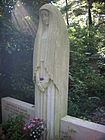Paul Stuckenbruck
Paul Hermann Robert Wilhelm Stuckenbruck (born March 11, 1868 in Leipzig ; † December 1, 1947 there ) was a sculptor and restorer .
Life
family
Paul was the son of the typesetter Ernst Stuckenbruck (1839–1890) and his wife Caroline, b. Scheppelmann (1842-1919). He was baptized in the Evangelical Reformed Church in Leipzig. Like his two sisters, Agnes (1873–1968) and Adele (1878–1954), he too remained unmarried and lived with them in his parents' apartment until his death.
education
He received his academic training from Easter 1883 to Easter 1890 at the Leipzig Art Academy near Melchior zur Strasse . After completing his studies, he worked as a journeyman with the Leipzig sculptor and medalist Adolf Lehnert . He then moved to Berlin , where he trained in the studio of Nikolaus Geiger , after his early death with Rudolf Siemering and from 1905 with Otto Lessing .
Creating art
Since the end of the 1890s Paul Stuckenbruck was represented with his own works at Leipzig art exhibitions. In the competition for the Kaiser Wilhelm Memorial in Chemnitz , he participated with a design that was also awarded a prize.
From 1912 he worked as a freelancer. He set up his studio in Leipzig. In November 1914 the memorial he made for Froebel pedagogue Angelika Hartmann was inaugurated in Koethen . In the following years he created numerous busts and relief panels , in bronze or marble were issued. A major source of income were sculptural works and designs for tombs, many of which were destroyed during the Second World War, destroyed or lost after the war. Today only a few works can be traced back to him, but they show his own formal language and artistic mastery.
Shortly before his 80th birthday, the artist died in the presence of his relatives. He was first buried in his parents' grave in the New Johannisfriedhof in Leipzig. When this cemetery was closed, the urn and tombstone were transferred to the Leipzig South Cemetery.
Works (selection)
- 1912 Angelika Hartmann bust, marble
- 1914 memorial for Angelika Hartmann , marble, Koethen
- 1931 Nietzschmann tomb, shell limestone, Leipzig south cemetery
- 1932 Langhoff tomb, travertine, Leipzig south cemetery
- 1932 Göttel tomb, shell limestone, Leipzig south cemetery
- 1934 portrait relief Paul Knaur, bronze, Südfriedhof Leipzig
- 1935 Bretschneider tomb, iron clinker, majolica, Leipzig south cemetery
- 1943 Fountain group of young brown bears , cast aluminum, Zoological Garden, Leipzig
- 1943 bust of a young girl with a fringe of hair, marble, art auction by Zezschwitz, auction 54, catalog no. 183 of July 3, 2009
- 1944 Copy of the bust on the Friedrich-Zöllner Monument, marble, Leipzig
- Bust of boy from Habana , marble, Museum of Fine Arts, Leipzig
- Bust girl from Habana , marble, Museum of Fine Arts, Leipzig
literature
- Alfred E. Otto Paul: The art in silence. Art treasures in Leipzig cemeteries, No. 04, Leipzig 2011, p. 100ff.
- Herwig Guratzsch (Ed.): Museum of Fine Arts Leipzig. Catalog of Bildwerke, Cologne 1999, passim.
Web links
- Description of the Bretschneider burial site
- Description of Nietzschmann's grave
- Stuckenbruck at the Zezschwitz art auction house, 2009
Individual evidence
- ↑ The studio was in the garden of an apartment building on Gottsched- / corner (today's) Käthe-Kollwitz-Straße. Due to the expansion and the associated renumbering of Gottschedstrasse at the end of the 1930s, the house number changed from 16 to 13. While the tenement house at Gottschedstrasse 13 still exists today, the garden house used by Stuckenbruck as a studio was demolished in the course of renovation measures.
| personal data | |
|---|---|
| SURNAME | Stuckenbruck, Paul |
| ALTERNATIVE NAMES | Stuckenbruck, Paul Hermann Robert Wilhelm (full name) |
| BRIEF DESCRIPTION | German sculptor |
| DATE OF BIRTH | March 11, 1868 |
| PLACE OF BIRTH | Leipzig |
| DATE OF DEATH | December 1, 1947 |
| Place of death | Leipzig |








